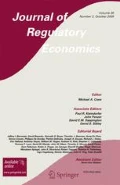Abstract
Price cap regulation (PCR) arose out of dissatisfaction with rate-of-return regulation (ROR). In energy and water there has been a move away from PCR into an extended form of ROR, referred to as guaranteed return regulation (GRR). It is employed to implement policies that legislators are unwilling to apply by transparent methods, namely taxation, but willing to apply opaquely through the regulatory process. GRR does not promote efficiency and, as the California experience shows, the guarantees it provides are limited. Its success in California has been mixed and it should be considered to be a work in progress and open to improvements, some of which are outlined.
Similar content being viewed by others
Notes
Some Canadian utilities currently employ PCR. In telecommunications it has been applied extensively, e.g. Sappington and Weisman (2010).
Rural telecommunications companies subject to ROR are subject to GRR on the carrier common line charge.
The framework of Sappington (2005) demonstrates this result. Let P(x, q) denote the price at which consumers demand x units of the product, each of quality q. Also let C(x, q) denote the firm’s cost of producing x units, each of quality q. Profit maximization requires \(\hbox {xP}_\mathrm{q}\hbox {(x, q)} ={\hbox {C}}_{\mathrm{q}}\hbox {(x,q)}\) the subscript q denotes the partial derivative with respect to q. This equality implies that if P is lowered by regulation as it is with a price cap, quality will be lowered.
\(\hbox {Profit} = \hbox {Px} - \hbox {C(x)}\). As under PCR, P = MR, profits will increase in x if \(\hbox {MR} > \hbox {MC}\).
In addition to this simple case, Brennan addresses the more complicated case where wholesale energy prices are greater or less than the price charged to the consumer. In this case, under price caps, the utility has an incentive to undertake conservation to reduce peak demand but to encourage off-peak consumption.
For a discussion of incentives for energy conservation see Chu and Sappington (2013).
Broer and Zwart (2013) suggest permitting a higher price cap the sooner investment is undertaken in order to provide an incentive for timely capital investment.
California Public Utilities Commission, Decision 05-05-015.
Presumably, if it were over-earning it might be more lax with expenses but this is the less likely scenario.
GRR provides for one rate change per year. However, utilities are entitled to other rate changes such as escalation increases, balancing account recovery, memorandum account recovery, etc.
The notion of regulation as a mechanism for taxes and subsidies is not new, e.g. Posner (1971). It has been used for cross subsidies for many years. However, its use for environmental policy is more recent and has brought about adaptions in regulation, in particular, GRR discussed here.
References
Brennan, T. J. (2010). Decoupling in electric utilities. Journal of Regulatory Economics, 38(1), 49–69.
Broer, P., & Zwart, G. (2013). Optimal regulation of lumpy investments. Journal of Regulatory Economics, 44(2), 177–196.
California Water Action Plan, California Public Utilities Commission, San Francisco, October 2010.
Chu, L. Y., & Sappington, D. E. M. (2013). Motivating energy suppliers to promote energy conservation. Journal of Regulatory Economics, 43(4), 229–247.
Littlechild, S. C. (1986). Economic regulation of privatised water authorities. London: Department of the Environment.
Posner, R. (1971). Taxation by regulation. The Bell Journal of Economics and Management Science Spring, 2(1), 22–55.
Sappington, D. E. M. (2005). Regulating service quality: A survey. Journal of Regulatory Economics, 27(2), 123–154.
Sappington, D. E. M., & Weisman, D. L. (2010). Price cap regulation: What have we learned from 25 years of experience in the telecommunications industry? Journal of Regulatory Economics, 38(3), 227–258.
Acknowledgments
They wish to thank David Sappington, JRE Associate Editor for handling this paper for his insights, which were invaluable in revising the paper. Paul Dudley, Victor Glass, Richard McCann, Carl Peterson, Dennis Weisman and two anonymous referees provided helpful comments.
Author information
Authors and Affiliations
Corresponding author
Additional information
Versions of this paper were presented at the ANEA \(4\mathrm{th}\) Conference on Water, Naples, October 4, 2012, the CRRI \(27\mathrm{th}\) Western Conference, Monterey, CA, June 19–21, June 2013, and the ACCC Conference, Brisbane, July 25–26, 2013.
Rights and permissions
About this article
Cite this article
Crew, M.A., Kahlon, R.S. Guaranteed return regulation: a case study of regulation of water in California. J Regul Econ 46, 112–121 (2014). https://doi.org/10.1007/s11149-014-9249-8
Published:
Issue Date:
DOI: https://doi.org/10.1007/s11149-014-9249-8




